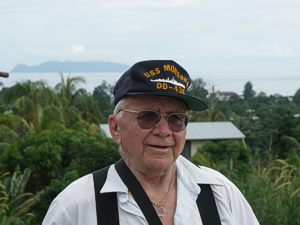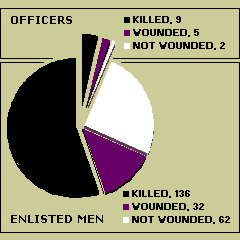

Shipmate Chet Thomason at Guadalcanal, 7 April 2006.
• Before daylight on that day in March 1942, with 13 officers on board, she grounded in 13 feet of water at the Cape Cod Canal’s buoy 13, a lighted buoy with a burned-out light—bad for the the ship, which returned to Boston Navy Yard for a new bow, but good for the crew, which gained a few extra weeks of leave in Beantown!
• That November, she was one of 13 Task Force 67 ships engaged in the Naval Battle of Guadalcanal, where she was sunk with three-quarters of her officers and men killed or wounded.
The circumstances of Monssen’s loss overshadowed a diverse record of participation in many key events of early World War II, both in the Atlantic and the Pacific. She was laid down at Puget Sound Navy Yard, Bremerton, Washington on 12 July 1939 and launched there on 15 May 1940; she was commissioned on 14 March 1941 under LCdr. Roland Smoot. Attached to Destroyer Squadron 11, she served in the Atlantic from June 1941 until March 1942 in neutrality patrols and “short of war” operations between New England and Iceland. Often operating with Kearny of her squadron, Monssen was in port she received news that Kearny had been torpedoed, 17 October. Monssen stood out, rendezvoused with Kearny and escorted her to Iceland.

Kearny (left) and Monssen lie off Iceland, October 1941, after Kearny sustained torpedo damage, visible amidships. From NARA photo 80-G-28788.
Detached from DesRon 11 and transferred to the Pacific, Destroyer Division 22 (Monssen with Gwin, Meredith and Grayson) joined Task Force 16 (carrier Hornet, cruisers Vincennes and Nashville and oiler Cimarron) for Lt. Col. “Jimmy” Doolittle’s raid on Tokyo in April. The task force then steamed to the South Pacific and, after missing the Battle of the Coral Sea, returned to Hawaii. In June, during the Battle of Midway, Monssen escorted Cimarron, then with Gwin stood by Yorktown as the latter was sunk. With her full division again, she then returned to the South Pacific in July for the beginning of the Guadalcanal campaign.
On the morning of 7 August, operating with Buchanan and San Juan (CL 53) as Fire Support Group “Mike” of Task Group 62.2, Monssen was first to open fire—on Florida Island—in preparation for the landing on Beach Blue, Tulagi, half an hour before the 2d Marines went ashore. That afternoon, when Marines attempting to seize nearby Gavutu Island were enfiladed by enemy fire from caves on adjacent Tanambogo, the two destroyers joined aircraft from carrier Wasp with an intense bombardment, though the islands were not secured until two days later. With the landings complete, Monssen returned to escort duty.
Monssen’s casualties at the Battle of Guadalcanal.

Source: Bureau of Personnel casualty report, NARA.
In November, under LCdr. Charles McCombs, Monssen escorted transports carrying reinforcements and supplies to Guadalcanal, helping fight off a Japanese air attack while they were unloading on the 12th. That night, she was part of a RAdm. Daniel J. Callaghan’s Task Force 67, which was ordered to intercept a Japanese battleship force attempting to bombard Henderson Field. The resulting gunfire and torpedo action, the first surface phase of the Naval Battle of Guadalcanal, prevented the enemy from achieving its objective but cost the US Navy one cruiser and four destroyers. Monssen was among the latter: disabled by Japanese gunfire after flashing her recognition lights as ordered, she was abandoned and burned until the following afternoon, when she sank. Her survivors swam and/or were picked up and taken to Guadalcanal.
In 1992, Monssen’s wreck was discovered and examined. She lies upright, over 2000 feet deep in Guadalcanal’s Ironbottom Sound. Her hull is intact, though damaged forward by explosions and aft by impact with the sea floor. Her 5-inch guns are trained out to starboard. While her forward 5-inch guns and superstructure show the effects of Japanese shells and fire, the after guns and deckhouses are in relatively good condition.
Also in 1992, on Friday, 13 November, exactly 50 years after she was lost, Monssen’s sole reunion was organized by shipmate Chet Thomason at the Radisson Hotel in San Diego. Most survivors had not seen each other since her sinking.
Source: Naval History & Heritage Command Photographic Section, DANFS history and first person accounts.